Insights into Molecular Mechanisms of Anticancer Activity of Juniperus communis Essential Oil in HeLa and HCT 116 Cells
Abstract
:1. Introduction
2. Results
2.1. J. communis Essential-Oil-Induced Selective Short-Term Cytotoxic Effects in HeLa and HCT 116 Cells
2.2. J. communis Essential-Oil-Induced Long-Term Cytotoxic Effects in HeLa and HCT 116 Cells
2.3. J. communis Essential-Oil-Induced Apoptosis in HeLa and HCT-116 Cells by Upregulating the Expression of Active Caspase-3 and Bax/Bcl-2 Protein Ratio
2.4. J. communis Essential Oil Treatment Altered the Mitochondrial Membrane Potential in HeLa and HCT 116 Cell Line
2.5. J. communis Essential Oil Treatment Inhibited MAPK/ERK and PI3K/Akt Cell Signaling Pathways of Cell Survival in HCT 116 Cell Line
2.6. J. communis Essential Oil Treatment Affected the Cell-Cycle Distribution in HeLa and HCT 116 Cells
2.7. J. communis Essential Oil Active Metabolites Bound to the NADH Ubiquinone Oxidoreductase Subunits 1, 2, 6 and Superoxide Dismutase
2.8. J. communis Essential Oil Treatment Decreased the O2•− Concentration and Downregulated the Superoxide Dismutase in HeLa and HCT 116 Cells
3. Discussion
4. Materials and Methods
4.1. Cell Lines
4.2. Compound Solutions
4.3. Cytotoxicity of Juniperus communis Essential Oil
4.4. Clonogenic Assay
4.5. Flow Cytometry Analysis of Apoptosis, Autophagy, and Protein Expression
4.6. Cell-Cycle Analysis
4.7. JC-10 and Cytochrome C Localization and Quantification
4.8. Molecular Docking Screening
4.9. Determination of Superoxide Anion Radical Concentration and Superoxide Dismutase Activity
4.10. Statistical Analysis
5. Conclusions
Supplementary Materials
Author Contributions
Funding
Data Availability Statement
Acknowledgments
Conflicts of Interest
References
- Ferlay, J.; Colombet, M.; Soerjomataram, I.; Parkin, D.M.; Piñeros, M.; Znaor, A.; Bray, F. Cancer Statistics for the Year 2020: An Overview. Int. J. Cancer 2021, 149, 778–789. [Google Scholar] [CrossRef] [PubMed]
- Pan, L.; Chai, H.; Kinghorn, A.D. The Continuing Search for Antitumor Agents from Higher Plants. Phytochem. Lett. 2010, 3, 1–8. [Google Scholar] [CrossRef]
- Osanloo, M.; Ghaznavi, G.; Abdollahi, A. Surveying the Chemical Composition and Antibacterial Activity of Essential Oils from Selected Medicinal Plants against Human Pathogens. Iran. J. Microbiol. 2020, 12, 577–583. [Google Scholar] [CrossRef]
- Valdivieso-Ugarte, M.; Gomez-Llorente, C.; Plaza-Díaz, J.; Gil, Á. Antimicrobial, Antioxidant, and Immunomodulatory Properties of Essential Oils: A Systematic Review. Nutrients 2019, 11, 2786. [Google Scholar] [CrossRef] [PubMed]
- Ishfaq, P.M.; Shukla, A.; Beraiya, S.; Tripathi, S.; Mishra, S.K. Biochemical and Pharmacological Applications of Essential Oils in Human Health Especially in Cancer Prevention. Anticancer Agents Med. Chem. 2018, 18, 1815–1827. [Google Scholar] [CrossRef]
- Dhifi, W.; Bellili, S.; Jazi, S.; Bahloul, N.; Mnif, W. Essential Oils’ Chemical Characterization and Investigation of Some Biological Activities: A Critical Review. Medicines 2016, 3, 25. [Google Scholar] [CrossRef] [PubMed]
- Shahmir, F.; Ahmadi, L.; Mirza, M.; Korori, S.A.A. Secretory Elements of Needles and Berries of Juniperus communis L. ssp. Communis and Its Volatile Constituents. Flavour Fragr. J. 2003, 18, 425–428. [Google Scholar] [CrossRef]
- Ložienė, K.; Labokas, J.; Venskutonis, P.R.; Maždžierienė, R. Chromatographic Evaluation of the Composition of Essential Oil and α-Pinene Enantiomers in Juniperus communis L. Berries during Ripening. J. Essent. Oil Res. 2010, 22, 453–458. [Google Scholar] [CrossRef]
- Xavier, V.; Finimundy, T.C.; Heleno, S.A.; Amaral, J.S.; Calhelha, R.C.; Vaz, J.; Pires, T.C.S.P.; Mediavilla, I.; Esteban, L.S.; Ferreira, I.C.F.R.; et al. Chemical and Bioactive Characterization of the Essential Oils Obtained from Three Mediterranean Plants. Molecules 2021, 26, 7472. [Google Scholar] [CrossRef]
- Elshafie, H.S.; Caputo, L.; De Martino, L.; Gruľová, D.; Zheljazkov, V.Z.; De Feo, V.; Camele, I. Biological Investigations of Essential Oils Extracted from Three Juniperus Species and Evaluation of Their Antimicrobial, Antioxidant and Cytotoxic Activities. J. Appl. Microbiol. 2020, 129, 1261–1271. [Google Scholar] [CrossRef]
- Mansour, R.B.; Wasli, H.; Bourgou, S.; Khamessi, S.; Ksouri, R.; Megdiche-Ksouri, W.; Cardoso, S.M. Insights on Juniperus Phoenicea Essential Oil as Potential Anti-Proliferative, Anti-Tyrosinase, and Antioxidant Candidate. Molecules 2023, 28, 7547. [Google Scholar] [CrossRef]
- Vasilijević, B.; Knežević-Vukčević, J.; Mitić-Ćulafić, D.; Orčić, D.; Francišković, M.; Srdic-Rajic, T.; Jovanović, M.; Nikolić, B. Chemical Characterization, Antioxidant, Genotoxic and in Vitro Cytotoxic Activity Assessment of Juniperus communis Var. Saxatilis. Food Chem. Toxicol. 2018, 112, 118–125. [Google Scholar] [CrossRef] [PubMed]
- Neophytou, C.M.; Trougakos, I.P.; Erin, N.; Papageorgis, P. Apoptosis Deregulation and the Development of Cancer Multi-Drug Resistance. Cancers 2021, 13, 4363. [Google Scholar] [CrossRef] [PubMed]
- Renehan, A.G.; Booth, C.; Potten, C.S. What Is Apoptosis, and Why Is It Important? BMJ 2001, 322, 1536–1538. [Google Scholar] [CrossRef] [PubMed]
- Carneiro, B.A.; El-Deiry, W.S. Targeting Apoptosis in Cancer Therapy. Nat. Rev. Clin. Oncol. 2020, 17, 395–417. [Google Scholar] [CrossRef] [PubMed]
- Vitale, I.; Pietrocola, F.; Guilbaud, E.; Aaronson, S.A.; Abrams, J.M.; Adam, D.; Agostini, M.; Agostinis, P.; Alnemri, E.S.; Altucci, L.; et al. Apoptotic Cell Death in Disease-Current Understanding of the NCCD 2023. Cell Death Differ. 2023, 30, 1097–1154. [Google Scholar] [CrossRef]
- Gharbaran, R.; Shi, C.; Onwumere, O.; Redenti, S. Plumbagin Induces Cytotoxicity via Loss of Mitochondrial Membrane Potential and Caspase Activation in Metastatic Retinoblastoma. Anticancer Res. 2021, 41, 4725–4732. [Google Scholar] [CrossRef]
- Hou, J.; Zhang, Y.; Zhu, Y.; Zhou, B.; Ren, C.; Liang, S.; Guo, Y. α-Pinene Induces Apoptotic Cell Death via Caspase Activation in Human Ovarian Cancer Cells. Med. Sci. Monit. 2019, 25, 6631–6638. [Google Scholar] [CrossRef]
- Abe, M.; Asada, N.; Kimura, M.; Fukui, C.; Yamada, D.; Wang, Z.; Miyake, M.; Takarada, T.; Ono, M.; Aoe, M.; et al. Antitumor Activity of α-Pinene in T-Cell Tumors. Cancer Sci. 2024, 115, 1317–1332. [Google Scholar] [CrossRef]
- Si, C.; Ou, Y.; Ma, D.; Hei, L.; Wang, X.; Du, R.; Yang, H.; Liao, Y.; Zhao, J. Cytotoxic Effect of the Essential Oils from Erigeron Canadensis L. on Human Cervical Cancer HeLa Cells in Vitro. Chem. Biodivers. 2022, 19, e202200436. [Google Scholar] [CrossRef]
- Huang, X.; Yan, P.; Ding, W.; Zhou, C.; Xu, Q.; Li, M.; Ye, L.; Chen, W. α-Pinene Inhibits the Growth of Cervical Cancer Cells through Its Proapoptotic Activity by Regulating the MiR-34a-5p/Bcl-2 Signaling Axis. Drug Dev. Res. 2022, 83, 1766–1776. [Google Scholar] [CrossRef]
- Vermeulen, K.; Berneman, Z.N.; Van Bockstaele, D.R. Cell Cycle and Apoptosis. Cell Prolif. 2003, 36, 165–175. [Google Scholar] [CrossRef] [PubMed]
- Wang, Y.; Wu, C.; Zhang, Q.; Shan, Y.; Gu, W.; Wang, S. Design, Synthesis and Biological Evaluation of Novel β-Pinene-Based Thiazole Derivatives as Potential Anticancer Agents via Mitochondrial-Mediated Apoptosis Pathway. Bioorganic Chem. 2019, 84, 468–477. [Google Scholar] [CrossRef]
- Xu, Q.; Li, M.; Yang, M.; Yang, J.; Xie, J.; Lu, X.; Wang, F.; Chen, W. α-Pinene Regulates MiR-221 and Induces G2/M Phase Cell Cycle Arrest in Human Hepatocellular Carcinoma Cells. Biosci. Rep. 2018, 38, BSR20180980. [Google Scholar] [CrossRef] [PubMed]
- Wirth, C.; Brandt, U.; Hunte, C.; Zickermann, V. Structure and Function of Mitochondrial Complex I. Biochim. Biophys. Acta Bioenerg. 2016, 1857, 902–914. [Google Scholar] [CrossRef] [PubMed]
- Kahlhöfer, F.; Gansen, M.; Zickermann, V. Accessory Subunits of the Matrix Arm of Mitochondrial Complex I with a Focus on Subunit NDUFS4 and Its Role in Complex I Function and Assembly. Life 2021, 11, 455. [Google Scholar] [CrossRef] [PubMed]
- Kroemer, G.; Pouyssegur, J. Tumor Cell Metabolism: Cancer’s Achilles’ Heel. Cancer Cell 2008, 13, 472–482. [Google Scholar] [CrossRef]
- Akatsuka, A.; Kojima, N.; Okamura, M.; Dan, S.; Yamori, T. A Novel Thiophene-3-Carboxamide Analog of Annonaceous Acetogenin Exhibits Antitumor Activity via Inhibition of Mitochondrial Complex I. Pharmacol. Res. Perspect. 2016, 4, e00246. [Google Scholar] [CrossRef]
- Zhou, Y.; Zou, J.; Xu, J.; Zhou, Y.; Cen, X.; Zhao, Y. Recent Advances of Mitochondrial Complex I Inhibitors for Cancer Therapy: Current Status and Future Perspectives. Eur. J. Med. Chem. 2023, 251, 115219. [Google Scholar] [CrossRef]
- Čmiková, N.; Vukic, M.D.; Vukovic, N.L.; Verešová, A.; Bianchi, A.; Garzoli, S.; Ben Saad, R.; Ben Hsouna, A.; Ban, Z.; Kačániová, M. Phytochemical Investigation, Evaluation of the Biological Activities and Preservative Effect of the Essential Oil of Juniperus communis L. Dried Berries on the Vacuum-Packed Carrot after the Application of Salmonella Enterica. Sci. Hortic. 2024, 336, 113442. [Google Scholar] [CrossRef]
- De Carvalho, N.R.; Rodrigues, N.R.; Macedo, G.E.; Bristot, I.J.; Boligon, A.A.; De Campos, M.M.; Cunha, F.A.B.; Coutinho, H.D.; Klamt, F.; Merritt, T.J.S.; et al. Eugenia uniflora Leaf Essential Oil Promotes Mitochondrial Dysfunction in Drosophila melanogaster through the Inhibition of Oxidative Phosphorylation. Toxicol. Res. 2017, 6, 526–534. [Google Scholar] [CrossRef]
- Duque, J.E.; Urbina, D.L.; Vesga, L.C.; Ortiz-Rodríguez, L.A.; Vanegas, T.S.; Stashenko, E.E.; Mendez-Sanchez, S.C. Insecticidal Activity of Essential Oils from American Native Plants against Aedes Aegypti (Diptera: Culicidae): An Introduction to Their Possible Mechanism of Action. Sci. Rep. 2023, 13, 2989. [Google Scholar] [CrossRef]
- Bridges, H.R.; Fedor, J.G.; Blaza, J.N.; Di Luca, A.; Jussupow, A.; Jarman, O.D.; Wright, J.J.; Agip, A.N.A.; Gamiz-Hernandez, A.P.; Roessler, M.M.; et al. Structure of Inhibitor-Bound Mammalian Complex I. Nat. Commun. 2020, 11, 5261. [Google Scholar] [CrossRef] [PubMed]
- Kmita, K.; Wirth, C.; Warnau, J.; Guerrero-Castillo, S.; Hunte, C.; Hummer, G.; Kaila, V.R.I.; Zwicker, K.; Brandt, U.; Zickermann, V. Accessory NUMM (NDUFS6) Subunit Harbors a Zn-Binding Site and Is Essential for Biogenesis of Mitochondrial Complex I. Proc. Natl. Acad. Sci. USA 2015, 112, 5685–5690. [Google Scholar] [CrossRef]
- Kirby, D.M.; Salemi, R.; Sugiana, C.; Ohtake, A.; Parry, L.; Bell, K.M.; Kirk, E.P.; Boneh, A.; Taylor, R.W.; Dahl, H.H.M.; et al. NDUFS6 Mutations Are a Novel Cause of Lethal Neonatal Mitochondrial Complex I Deficiency. J. Clin. Investig. 2004, 114, 837–845. [Google Scholar] [CrossRef]
- Urra, F.A.; Muñoz, F.; Lovy, A.; Cárdenas, C. The Mitochondrial Complex(I)Ty of Cancer. Front. Oncol. 2017, 7, 118. [Google Scholar] [CrossRef] [PubMed]
- Bastian, A.; Matsuzaki, S.; Humphries, K.M.; Pharaoh, G.A.; Doshi, A.; Zaware, N.; Gangjee, A.; Ihnat, M.A. AG311, a Small Molecule Inhibitor of Complex I and Hypoxia-Induced HIF-1α Stabilization. Cancer Lett. 2017, 388, 149. [Google Scholar] [CrossRef]
- Lim, S.C.; Carey, K.T.; McKenzie, M. Anti-Cancer Analogues ME-143 and ME-344 Exert Toxicity by Directly Inhibiting Mitochondrial NADH: Ubiquinone Oxidoreductase (Complex I). Am. J. Cancer Res. 2015, 5, 689. [Google Scholar] [PubMed]
- Tabassum, N.; Kheya, I.; Ibn Asaduzzaman, S.; Maniha, S.; Fayz, A.; Zakaria, A.; Fayz, A.; Zakaria, A.; Noor, R. A Review on the Possible Leakage of Electrons through the Electron Transport Chain within Mitochondria. J. Biomed. Res. Environ. Sci. 2020, 1, 105–113. [Google Scholar] [CrossRef]
- Nakamura, H.; Takada, K. Reactive Oxygen Species in Cancer: Current Findings and Future Directions. Cancer Sci. 2021, 112, 3945. [Google Scholar] [CrossRef]
- Huang, P.; Feng, L.; Oldham, E.A.; Keating, M.J.; Plunkett, W. Superoxide Dismutase as a Target for the Selective Killing of Cancer Cells. Nature 2000, 407, 390–395. [Google Scholar] [CrossRef] [PubMed]
- Targeted Inhibition of Superoxide Dismutase 1 Is Effective in NSCLC. Cancer Discov. 2014, 4, OF15. [CrossRef]
- Mosmann, T. Rapid Colorimetric Assay for Cellular Growth and Survival: Application to Proliferation and Cytotoxicity Assays. J. Immunol. Methods 1983, 65, 55–63. [Google Scholar] [CrossRef] [PubMed]
- NCI-60 Screening Methodology|NCI-60 Human Tumor Cell Lines Screen|Discovery & Development Services|Developmental Therapeutics Program (DTP). Available online: https://dtp.cancer.gov/discovery_development/nci-60/methodology.htm (accessed on 8 July 2024).
- Vukic, M.D.; Vukovic, N.L.; Popovic, S.L.; Todorovic, D.V.; Djurdjevic, P.M.; Matic, S.D.; Mitrovic, M.M.; Popovic, A.M.; Kacaniova, M.M.; Baskic, D.D. Effect of β-Cyclodextrin Encapsulation on Cytotoxic Activity of Acetylshikonin against HCT-116 and MDA-MB-231 Cancer Cell Lines. Saudi Pharm. J. 2020, 28, 136–146. [Google Scholar] [CrossRef]
- Trott, O.; Olson, A.J. AutoDock Vina: Improving the Speed and Accuracy of Docking with a New Scoring Function, Efficient Optimization and Multithreading. J. Comput. Chem. 2010, 31, 455. [Google Scholar] [CrossRef]
- Guo, R.; Zong, S.; Wu, M.; Gu, J.; Yang, M. Architecture of Human Mitochondrial Respiratory Megacomplex I2III2IV2. Cell 2017, 170, 1247–1257.e12. [Google Scholar] [CrossRef]
- Sea, K.; Sohn, S.H.; Durazo, A.; Sheng, Y.; Shaw, B.F.; Cao, X.; Taylor, A.B.; Whitson, L.J.; Holloway, S.P.; Hart, P.J.; et al. Insights into the Role of the Unusual Disulfide Bond in Copper-Zinc Superoxide Dismutase. J. Biol. Chem. 2015, 290, 2405–2418. [Google Scholar] [CrossRef]
- Pettersen, E.F.; Goddard, T.D.; Huang, C.C.; Couch, G.S.; Greenblatt, D.M.; Meng, E.C.; Ferrin, T.E. UCSF Chimera--a Visualization System for Exploratory Research and Analysis. J. Comput. Chem. 2004, 25, 1605–1612. [Google Scholar] [CrossRef]
- Becke, A.D. Density-functional Thermochemistry. III. The Role of Exact Exchange. J. Chem. Phys. 1993, 98, 5648–5652. [Google Scholar] [CrossRef]
- Dunning, T.H. Gaussian Basis Sets for Use in Correlated Molecular Calculations. I. The Atoms Boron through Neon and Hydrogen. J. Chem. Phys. 1989, 90, 1007–1023. [Google Scholar] [CrossRef]
- Lee, C.; Yang, W.; Parr, R.G. Development of the Colle-Salvetti Correlation-Energy Formula into a Functional of the Electron Density. Phys. Rev. B Condens. Matter 1988, 37, 785–789. [Google Scholar] [CrossRef] [PubMed]
- Tian, W.; Chen, C.; Lei, X.; Zhao, J.; Liang, J. CASTp 3.0: Computed Atlas of Surface Topography of Proteins. Nucleic Acids Res. 2018, 46, W363–W367. [Google Scholar] [CrossRef] [PubMed]
- BIOVIA: Accelerate Your Scientific Innovation|Dassault Systèmes. Available online: https://www.3ds.com/products/biovia (accessed on 8 July 2024).
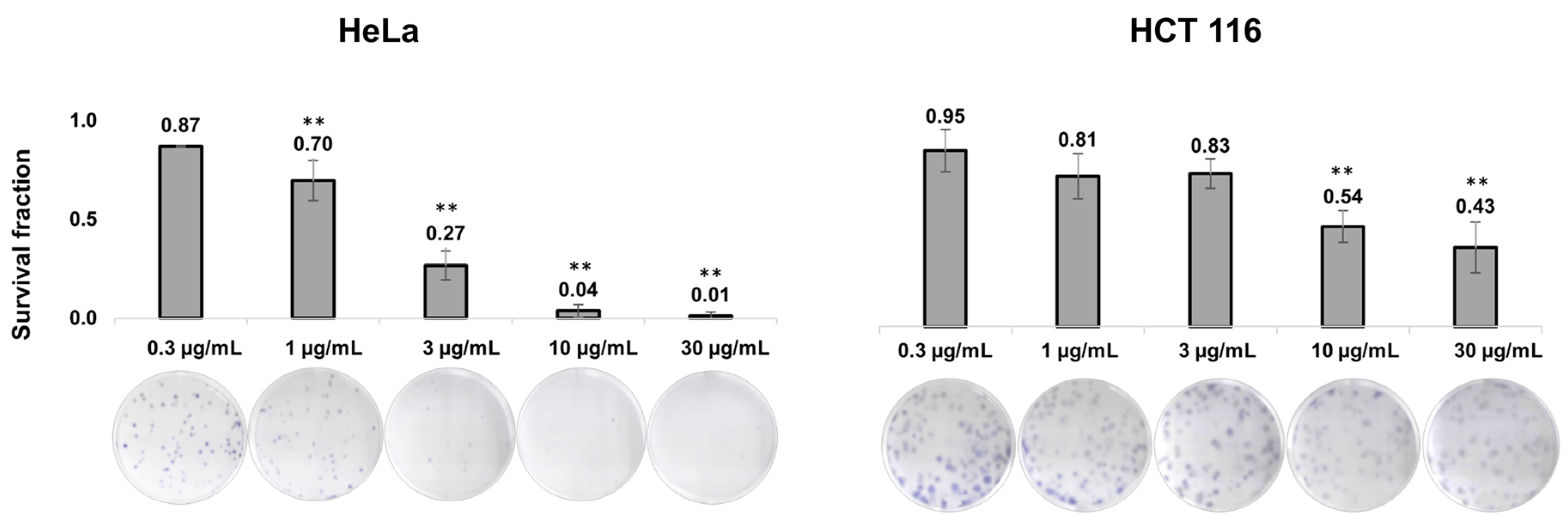


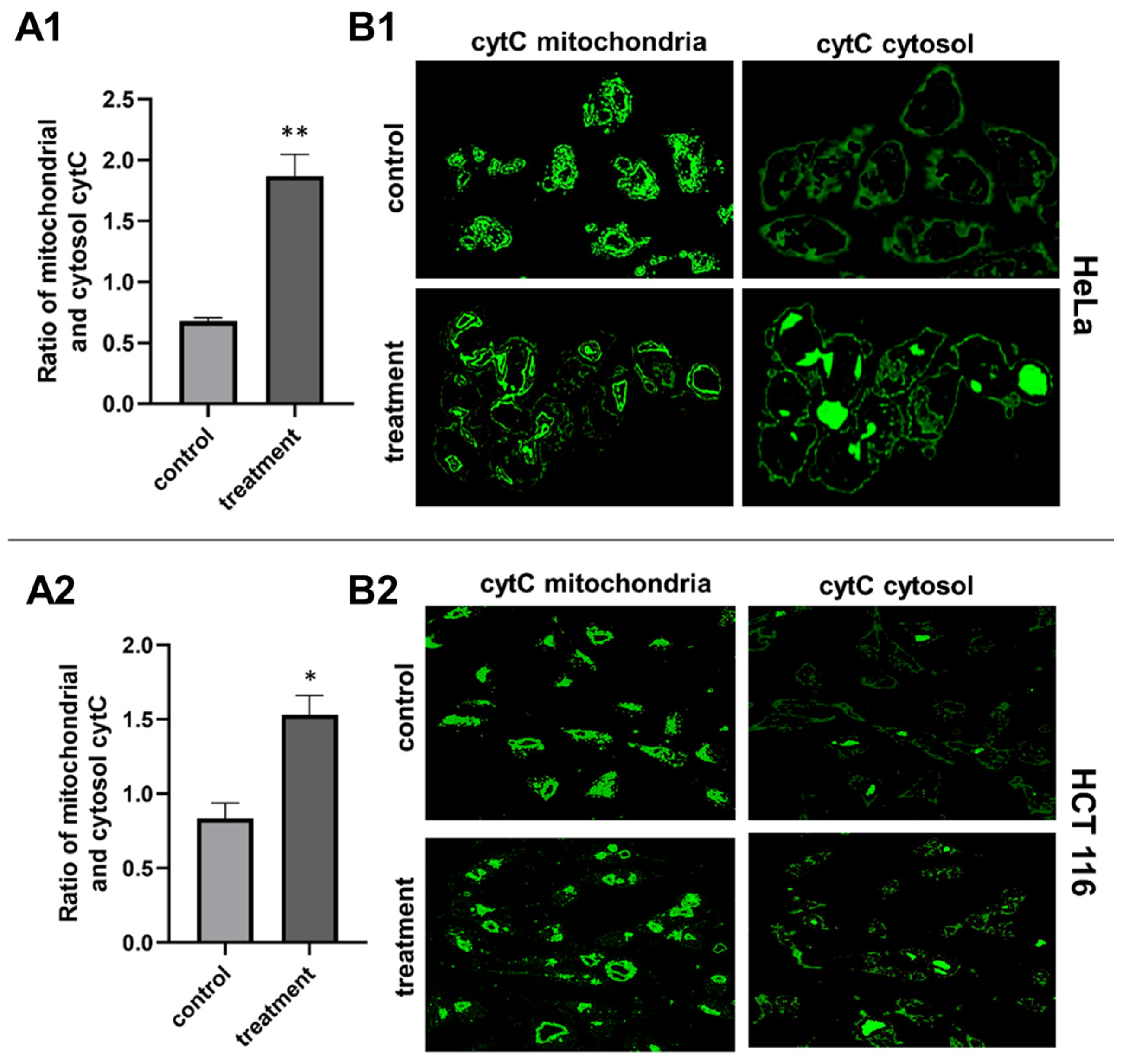
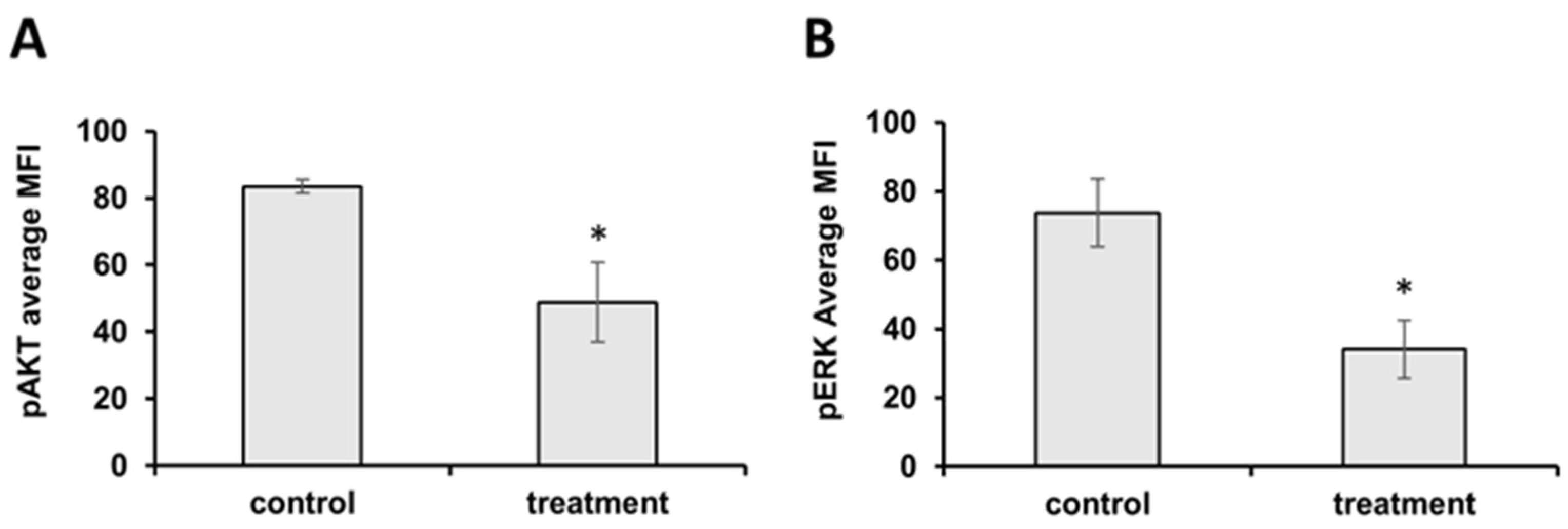

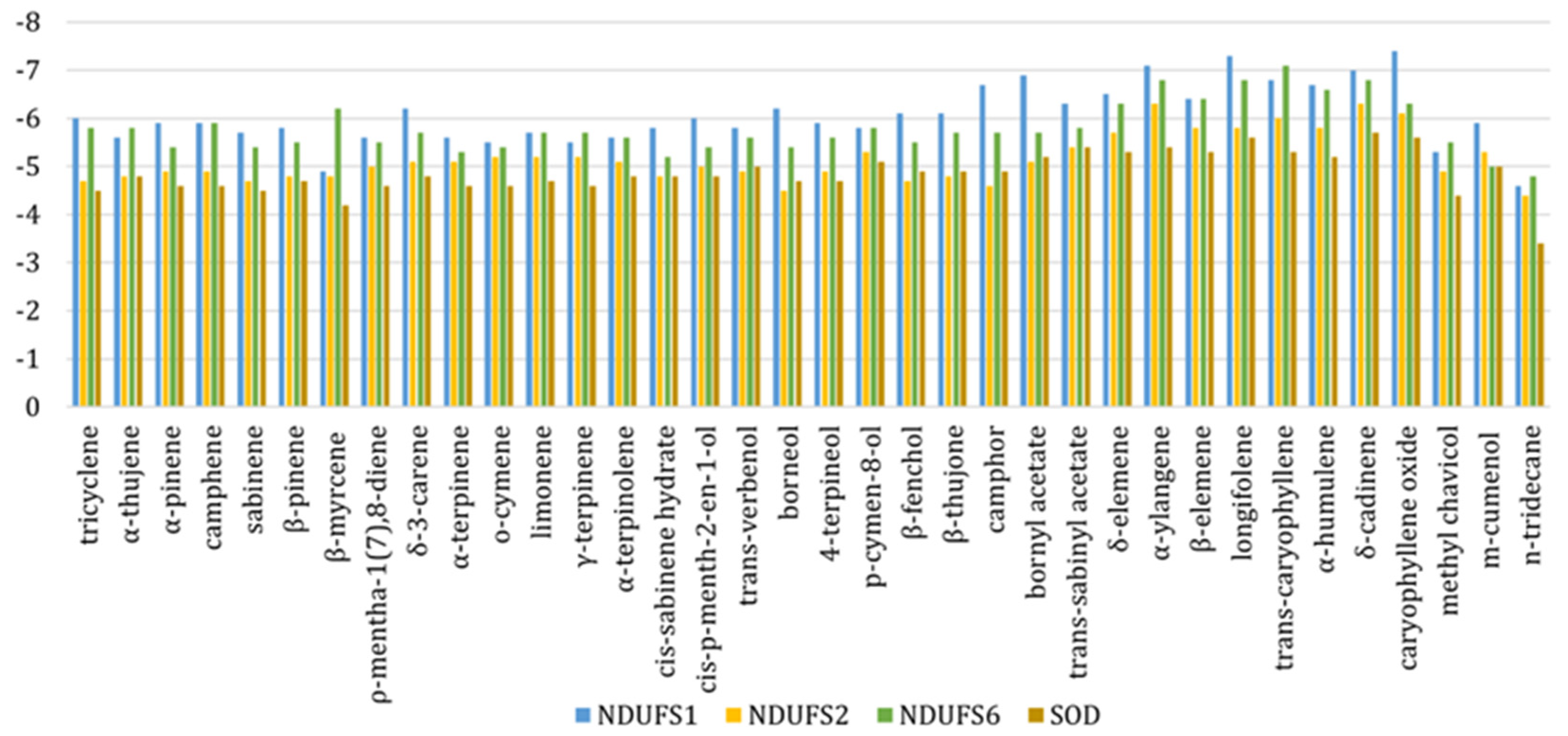



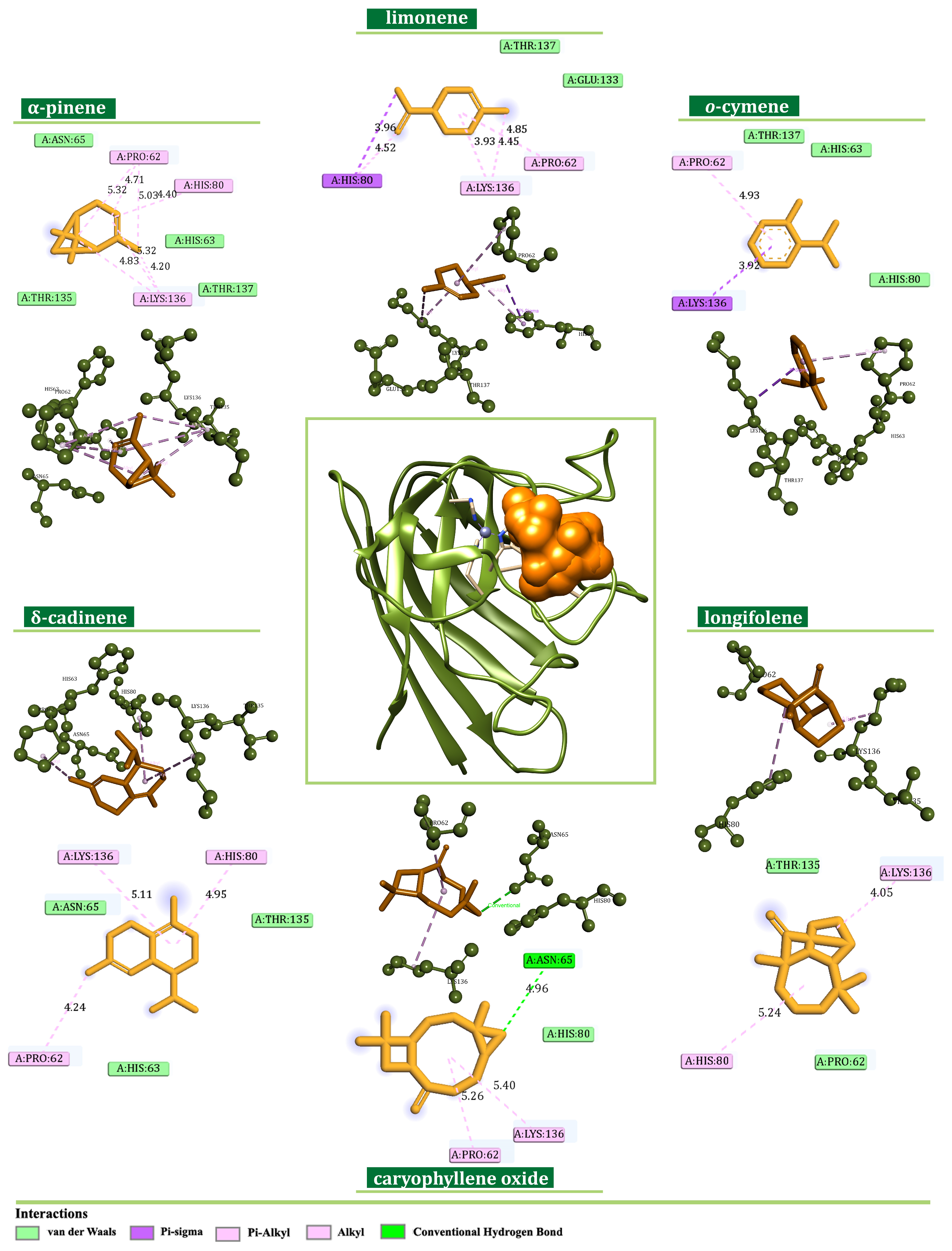


| Cell Line | Incubation Time (h) | IC50 ± SD | SI | GI50 ± SD | TGI ± SD | LD50 ± SD |
|---|---|---|---|---|---|---|
| MRC-5 | 24 | 88.02 ± 28.00 | NA | 36.98 ± 11.32 | 72.23 ± 22.58 | >100 |
| 48 | 34.86 ± 5.32 | NA | 31.33 ± 4.61 | 59.79 ± 9.69 | >100 | |
| 72 | 27.88 ± 3.19 | NA | 21.75 ± 7.21 | 48.26 ± 8.59 | 99.51 ± 18.91 | |
| HeLa | 24 | 15.84 ± 4.20 * | 5.56 | 12.18 ± 0.86 | 21.55 ± 0.77 * | >100 |
| 48 | 10.14 ± 2.89 * | 3.44 | 8.04 ± 3.91 * | 17.35 ± 7.55 * | >100 | |
| 72 | 10.29 ± 2.02 * | 2.71 | 9.02 ± 2.93 | 20.43 ± 2.04 * | 31.12 ± 0.04 * | |
| HCT 116 | 24 | 40.51 ± 34.59 | 2.17 | 34.63 ± 16.43 | 61.51 ± 16.40 | 74.02 ± 38.82 |
| 48 | 29.19 ± 6.12 ^ | 1.19 | 30.71 ± 12.49 ^ | 52.54 ± 21.89 | 74.88 ± 27.03 | |
| 72 | 25.25 ± 9.96 | 1.10 | 26.80 ± 9.29 ^ | 50.62 ± 18.64 ^ | 73.91 ± 23.06 ^ |
Disclaimer/Publisher’s Note: The statements, opinions and data contained in all publications are solely those of the individual author(s) and contributor(s) and not of MDPI and/or the editor(s). MDPI and/or the editor(s) disclaim responsibility for any injury to people or property resulting from any ideas, methods, instructions or products referred to in the content. |
© 2024 by the authors. Licensee MDPI, Basel, Switzerland. This article is an open access article distributed under the terms and conditions of the Creative Commons Attribution (CC BY) license (https://creativecommons.org/licenses/by/4.0/).
Share and Cite
Marković, T.; Popović, S.; Matić, S.; Mitrović, M.; Anđić, M.; Kočović, A.; Vukić, M.; Petrović, V.; Branković, J.; Vuković, N.; et al. Insights into Molecular Mechanisms of Anticancer Activity of Juniperus communis Essential Oil in HeLa and HCT 116 Cells. Plants 2024, 13, 2351. https://doi.org/10.3390/plants13172351
Marković T, Popović S, Matić S, Mitrović M, Anđić M, Kočović A, Vukić M, Petrović V, Branković J, Vuković N, et al. Insights into Molecular Mechanisms of Anticancer Activity of Juniperus communis Essential Oil in HeLa and HCT 116 Cells. Plants. 2024; 13(17):2351. https://doi.org/10.3390/plants13172351
Chicago/Turabian StyleMarković, Tijana, Suzana Popović, Sanja Matić, Marina Mitrović, Marijana Anđić, Aleksandar Kočović, Milena Vukić, Vladimir Petrović, Jovica Branković, Nenad Vuković, and et al. 2024. "Insights into Molecular Mechanisms of Anticancer Activity of Juniperus communis Essential Oil in HeLa and HCT 116 Cells" Plants 13, no. 17: 2351. https://doi.org/10.3390/plants13172351







